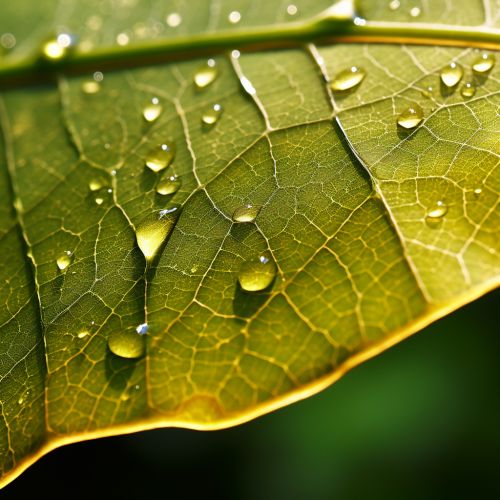Plant Cuticle
Introduction
The plant cuticle is a protective layer covering the outermost surface of the plant, particularly the leaves, fruits, and flowers. This waxy layer plays a crucial role in plant survival, acting as a barrier against environmental stressors such as desiccation, UV radiation, and pathogen attack.
Structure and Composition
The cuticle is primarily composed of two main components: cutin and cuticular wax. Cutin, a complex polyester, forms the structural matrix of the cuticle, while cuticular wax, a mixture of long-chain fatty acids and their derivatives, impregnates and covers the cutin matrix.


Cutin
Cutin is a complex biopolymer primarily composed of hydroxy and epoxy fatty acids. It forms a three-dimensional network that provides structural integrity to the cuticle. The exact composition and structure of cutin can vary significantly between different plant species, and even between different organs within the same plant.
Cuticular Wax
Cuticular wax is a mixture of long-chain fatty acids and their derivatives, including alcohols, aldehydes, ketones, and esters. These compounds are synthesized in the epidermal cells and are then transported to the outer surface of the cuticle, where they form a layer of wax crystals. The wax layer provides a hydrophobic barrier that prevents water loss and protects the plant from environmental stressors.
Function
The primary function of the plant cuticle is to prevent water loss from the plant's surface, a process known as transpiration. By providing a hydrophobic barrier, the cuticle reduces the rate of water evaporation from the plant's surface, helping the plant conserve water and survive in dry conditions.
The cuticle also serves as a physical barrier against pathogen attack. The waxy layer prevents the adhesion and penetration of many types of fungal spores and bacterial cells, reducing the plant's susceptibility to disease.
In addition to these protective functions, the cuticle also plays a role in plant development and reproduction. It influences the shape and structure of plant organs, and in some species, it is involved in the dispersal of seeds or fruits.
Development
The development of the plant cuticle begins early in the plant's life cycle, with the formation of the cuticle layer occurring during the differentiation of the epidermal cells. The biosynthesis of cutin and cuticular wax takes place in the epidermal cells, with these compounds being transported to the cell surface via a process known as transpiration.
The development and composition of the cuticle can be influenced by a variety of environmental factors, including light, temperature, and humidity. For example, plants grown in dry conditions often have a thicker cuticle with a higher wax content, which helps them conserve water and survive in these conditions.
Ecological Significance
The plant cuticle has significant ecological implications. By reducing water loss, the cuticle enables plants to survive in a wide range of environments, from arid deserts to humid rainforests. This has allowed plants to colonize virtually every terrestrial habitat on Earth.
The cuticle also plays a role in plant-animal interactions. For example, the waxy surface of the cuticle can deter herbivores, while certain insects use cues from the cuticle to identify their host plants.
Conclusion
The plant cuticle is a vital component of the plant's defense system, providing protection against environmental stressors and contributing to plant survival and reproduction. Its complex structure and composition, as well as its diverse functions, make it a fascinating subject of study in plant biology.
